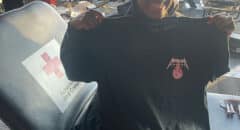 When a person hears the name, Pam Grier, many are transported in time back to when blaxploitation films ruled the theaters and pictures of a curvaceous Foxy Brown flash in their heads. Pam Grier was always portrayed as the tough, yet sexy, heroine able to handle herself in any situation. But her toughest fight was yet to come: her fight against cervical cancer.
When a person hears the name, Pam Grier, many are transported in time back to when blaxploitation films ruled the theaters and pictures of a curvaceous Foxy Brown flash in their heads. Pam Grier was always portrayed as the tough, yet sexy, heroine able to handle herself in any situation. But her toughest fight was yet to come: her fight against cervical cancer.
At the time she experienced cancer, Pam Grier felt in limbo. People she knew were moving on with their lives, but not her. “It was the ’80s and everyone was buying a second and third home and moving into lifestyles that were fruitful,” she says. “I was thinking I would have that. It was time to get married, maybe have children, and it all came to a screeching halt. My life and my journey took another route, but it made me stronger.”
Even though her cousin, Krista, whom Grier considered an adopted sister, died of breast cancer, the news of her own diagnosis of cervical cancer came as a shock. “Other than my sister, there is no history of cancer in my family,” she says. “We think hers was possibly from being a flight attendant because a lot of women became very ill working in those types of environments.”
In her book, Foxy: My Life in Three Acts, Grier spoke about coming to terms with Krista’s death and fighting for her own health after the diagnosis and related surgeries.
When she was told she had cervical cancer in 1988—the doctors gave her only 18 months to live—Grier had just completed a new movie, Above the Law, that ultimately returned Grier to the big screen after a seven-year absence. But cancer cancelled her comeback.
What’s more, after Grier’s first surgery, her doctor found the cancer was more widespread than previously thought so she underwent a second procedure to remove more cancerous tissue.
After this second surgery, her doctor suggested she add Eastern medicine to the prescribed traditional Western drug treatment. She met with Chinese herbalists who provided her with a more balanced treatment, and she also researched various methods of healing.
Check Out: Mr. T ‘Pity’s the Fool’ With Cancer
Around this time, she saw a Bill Moyers documentary that showed a Chinese medical treatment dissolve a malignant tumor on a Chinese woman’s back. It was a revelation to Grier. “I resolved to use the proper positive thinking to investigate Eastern healing methods,” she says.
Grier visited Chinatown and met a variety of people with different economic backgrounds who subscribed to Eastern medicine. “It was all new to me,” she says. “It was fascinating to me that so many people were so much more progressive and open than I had been. I learned a lot along the way.”
What Grier learned was that other cultures’ health theories could also benefit her. She retooled her eating habits and incorporated more organic foods in her diet.
She also started to practice yoga and include other health principles into her everyday routine. “I learned about thermal theory—that if you drink ice-cold water in the morning, it boosts your metabolism,” Grier says. “Simple things like that have awakened and informed my way of eating, and [now I use] moderation to minimize certain foods in the diet we know aren’t healthy.”
Today, in the age of information, the internet makes valuable information about wellness and eating readily accessible, but Grier fears that not everyone values it. “A lot of adults stop their education when they leave high school or college, and they don’t continue because they’re too busy working or raising children,” she says, pointing out that it doesn’t have to be that way. “Now children are being exposed to health and wellness advice. It’s great when families can learn about these things together.”
Visit the BlackDoctor.org Cancer center for more articles.









